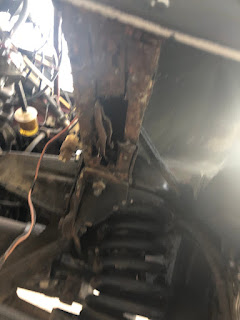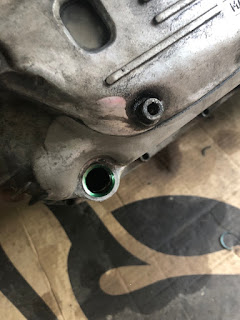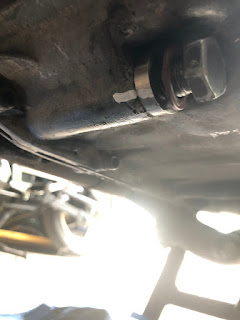As seen in the last post Comrade Car is starting to make a good first
impression on the outside and the previous attempts at fixing all those holes
on the underside suggest that this part is done as well. Except it isn't.
First of all there's a few technical items that need fixing/need to be
replaced, like this absolutely beautiful weld repair on the resonator may
suggest.
Or "a bit of" oil seeping from the steering box. (Mind you, this is normally a
sort of "hotspot" for finding rust... this one's very, very well
preserved.)
Following the theme of the resonator repair, there was one more spot, which
was lovingly repaired by adding layer over layer of sheet metal onto the front
frame member, which in the end looked a lot like a rusty piece of pastry.
(Sorry for the shaky picture - just be happy that it somewhat spared you the
actual extent of destruction.
The pile would grow quite substantially after peeling back those first few
layers.
After peeling back all those sheets of rusty and rotten sheetmetal, I found
the actual front bumper mount lying in there. That in itself wouldn't warrant
all the effort, weren't it for the fact that this bit also forms on of the two
mounting points for the towing hooks on the front. Given the overall surprises
with this car, I'd rather rely on a towing hook, I made sure was anchored down
solid rather than... well you know. On top of that mounting the front bumper
properly, definitely won't make passing the inspection more difficult.
And that's a proper bit of 3mm thick plate welded on, giving that element the
kind of strength I want to see in it.
Whilst this was a VERY important fix on the underside of Comrade Car, the
whole ordeal started with what was at most a slightly bigger pinhole, caused
by wet mud piling up on the inside of the sill. (Again - but this time it's
the other side.)
Shortly after, well the shortly part is a bit of a lie, that bit is not going to give me trouble again any
time soon.
It was at this point that I decided to remove the lift points for the factory
jack, because a) I don't have one, b) they were quite rusty (yet structurally
sound) and c) one of the mounts, I welded on was crooked.
Which was a good idea, because look what I found.
Engage no prisoner mode. Luckily it was in a relatively easy to reach spot now
that the lift point was removed.
Downside of no prisoner mode is that one has to take into account that some losses may occur. So the mount for the rear axle longitudinal struts, wasn't looking too fresh anymore. (Not without plenty of sand and dry dirt ending up on my face again.)
Whilst annoying the real problem lay in those two relatively small holes I tore into the floor plate.
Not exactly very big, but beautifully illuminated with some dangerous looking red light...
Admittedly, the holes themselves aren't the big problem. But the fuel tank and filler neck right above it surely are.
So out came the fuel tank, which to be honest was a lot easier than anticipated. Definitely helped by the fact that there was next to no fuel left inside.
This also meant that I could simplify the whole fuel system by quite a bit and install proper hoseclamps and new flexible lines.
Probably the main simplification was to remove the post 1986 breather system from the fuel tank, which included some several valves, carbon filled breather boxes and enough hoses to make someone with a rubber fetish very, very happy. Also the return-line, which is only needed with the later Solex carb was removed. The solution for the new breather is remarkably low tech and can be seen on numerous motorcycles.
... and with the tank out the remaining spots could be patched up, without me worrying on whether the car would actually explode or just burn down slowly.
... and this spot marked the last planned rust repair on the underside of the car - because one of the pre-owners couldn't get the correct towbar for a 1600, they "installed" most of what they had from a 1700 kit. And with installed I mean they welded it to the frame.
Said towbar will be the star of the next update, because how could you have a car without one?






















































